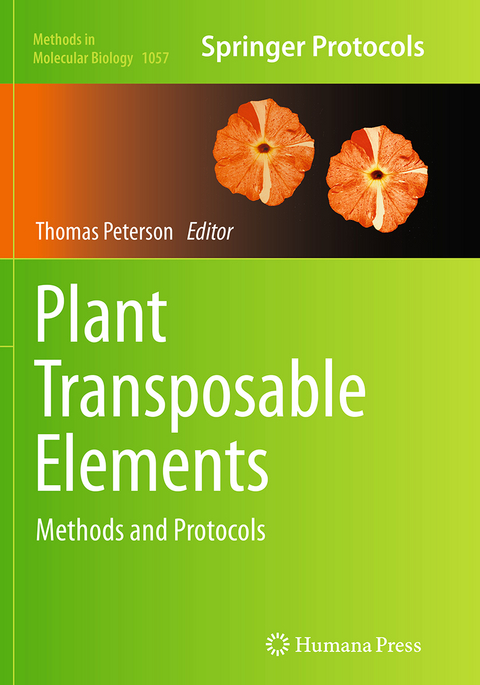
Plant Transposable Elements
Humana Press Inc. (Verlag)
978-1-4939-6271-6 (ISBN)
Transposable elements have played a major role in shaping plant genome structure and gene expression. Transposons not only drive sequence expansion, induce mutations and generate chromosome rearrangements, they also help to shape the epigenetic topology of the eukaryotic genome. In Plant Transposable Elements: Methods and Protocols, expert researchers in the field detail many of the methods which are now commonly used to study transposons. These methods include computational approaches to study the ancient transposon remnants that comprise the bulk of plant genomes, as well as laboratory techniques to identify recent and ongoing transposition events. Written in the highly successful Methods in Molecular Biology™ series format, chapters include introductions to their respective topics, lists of the necessary materials and reagents, step-by-step, readily reproducible laboratory protocols, and key tips on troubleshooting and avoiding known pitfalls.
Authoritative and practical, Plant Transposable Elements: Methods and Protocols seeks to aid scientists in the further study of transposons by providing essential background information and specific experimental protocols.
Historical Overview of Transposable Element Research.- Distinguishing Variable Phenotypes from Variegation Caused by Transposon Activities.- Using Transposons for Genetic Mosaic Analysis of Plant Development.- Survey of Natural and Transgenic Gene Markers Used to Monitor Transposon Activity.- Molecular Biology of Maize Ac/Ds Elements – an Overview.- Gene Tagging with Engineered Ds Elements in Maize.- Plant Regeneration Methods for Rapid Generation of a Large Scale of Ds Transposant Population in Rice.- Isolation of Sequences Flanking Ac Insertion Sites by Ac Casting.- Regulation of the Mutator System of Transposons in Maize.- Using MuDR/Mu Transposons in Directed Tagging Strategies .- Genetic and Molecular Analysis of UniformMu Transposon Insertion Lines.- Digestion-Ligation-Amplification (DLA): A Simple Genome Walking Method to Amplify Unknown Sequences Flanking Mutator (Mu) Transposons and Thereby Facilitate Gene Cloning.- Molecular Genetics and Epigenetics of CACTA Elements.- Activation Tagging Using the Maize En-I Transposon System for the Identification of Abiotic Stress Resistance Genes in Arabidopsis.- Reverse Genetics in Rice using Tos17.- Identification and Applications of the Petunia Class II Act1/dTph1 Transposable Element System.- Transposon Display: A Versatile Method for Transposon Tagging.- Massive Indexed Parallel Identification of Transposon Flanking Sequences.- Use of Next Generation Sequencing (NGS) Technologies for the Genome-wide Detection of Transposition.- Overview of Repeat Annotation and de novo Repeat Identification.- Computational Methods for Identification of DNA Transposons.- TEnest 2.0:Computational Annotation and Visualization of Nested Transposable Elements.
| Erscheinungsdatum | 04.10.2016 |
|---|---|
| Reihe/Serie | Methods in Molecular Biology ; 1057 |
| Zusatzinfo | 23 Illustrations, color; 38 Illustrations, black and white; XV, 324 p. 61 illus., 23 illus. in color. |
| Verlagsort | Totowa, NJ |
| Sprache | englisch |
| Maße | 178 x 254 mm |
| Themenwelt | Naturwissenschaften ► Biologie ► Botanik |
| Naturwissenschaften ► Biologie ► Genetik / Molekularbiologie | |
| ISBN-10 | 1-4939-6271-X / 149396271X |
| ISBN-13 | 978-1-4939-6271-6 / 9781493962716 |
| Zustand | Neuware |
| Haben Sie eine Frage zum Produkt? |
aus dem Bereich


